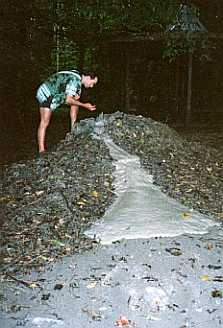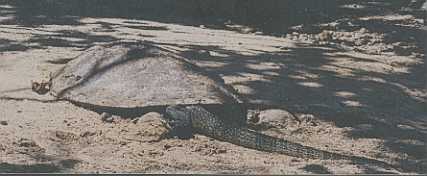Singapore and Borneo, June 1999
After a couple of months working as in a call centre for Vodafone, it was time for another break. Tracy Dorrington and I packed our bags, and hoped onto a Gulf Air flight to Singapore, leaving the bikes behind this time.
We arrived in the air-conditioned pristine airport, perfumed by violet orchids, and I was immediately impressed. Even the McDonalds seemed appealing, or was I just really tired from the overnight flight? Walking out of the airport to catch the bus to the city was a shock – a bit like the reaction one would have if you accidentally stuck your head in an oven heated to 220. Within 2 minutes I was soaked with sweat, after all I had been in a semi-cryogenic state after several months in London, so I associated this sort of heat normally with roasting marshmallows and frying eggs.
The bus to the city turned out to be air-conditioned. One would consider this to be a good thing, but since my body had spent several minutes acclimatising to the heat, getting into the bus was a bit like jumping from the frying pan into the fridge. I admired the freeway, strewn with bougainvillaea, the twisted buildings, and beautiful beach front, although the view was a bit blurred due to cranial vibrations caused by my teeth chattering from the cold.
Then it was out of the fridge and back into the fire, without any time for defrosting. The couple of hundred meter walk to the hostel we were staying seemed like a marathon through the sinking sands of the Sahara. Not that we learnt anything from this experience, because as soon as we had dumped our bags we were off to explore the city. After two blocks we had already lost several kilograms due to fluid loss. The welcome site of a white ice-cream van at the edge of a cricket pavillion turned out to be a cruel mirage, forcing upon us the sad truth that we would probably have to spend the day in the semi-comfort of our hostel acclimatising before venturing out to explore further.
Thanks to jet lag and disrupted sleeping patterns, we were up very early the next day to enjoy the birds on bikes at the local bird park, and the polar bears at the Singapore zoo. That’s right, polar bears. Although they were slightly yellow – green because the apparantly the warm temperatures and polar bear fur provide ideal breeding grounds for algae.
The highlight of the zoo trip for me was the elephant performance. An Indian elephant and a Malaysian elephant (looks like the Indian elephant but is smaller and hairier) did the usual standing on one leg, throwing balls to each other, and rolling over playing dead type tricks. Then as the grand finale the Malaysian elephant did a pirouette, spun round and blasted the crowd with mucousy water shot from its trunk. It was funny because I was at the back and didn’t get too wet, and also because I could see the twinkle in the eye and the happy smile of the elephant, for what must also be the highlight of its day – revenge on the squealing, camera clicking tourists.
The following day it was time to leave the mod-cons of the smooth functioning, polished city of Singapore to head to Johor Bahru – the ugly twin city on the tip of the peninsula of Malaysia, full of noisy, smoke belchinng scooters. Our stay here was mercifully short as it was merely our departure point for the capital of the Sarawak, the Malaysian province on the northern side of the island of Borneo. Kuching, the city of cats, was to be our gateway to Bako National Park. Here we had our first encounters with the curious proboscis monkeys, bearded pigs, and marauding makaks. Although we went for long walks to try see these in the wild, most of these are best seen close to the camp. The makaks are the best value for money – they ‘mugged’ a trio of Japanese girls for their bananas, and once when I interrupted a couple copulating on the pathway to our bungalow the female was so irate that I was the reason for her coitus-interruptus that she bit me on the leg!
We also met a great local Chinese business-man at the park. He was in charge of the construction work at several of the parks and rehabilitation centres. Thanks to him we got a behind the scenes tour of one of the local wildlife rehabilitation centres, where we got to shake hands with orangutangs. One of the poor buggers in the centre didn’t have a tongue, apparently because it had got it stuck in a can of paint, and so the tongue had to be removed along with the can of paint. So much for rehabilitation!
Our journey took us north-east along the coast to one of the world’s largest caves. We arrived at the entrance of the cave at dusk, in time to see one of natures more spectacular sites. Above our heads a mass of swallows cartwheeled and darted like leaves blown chaotically by a gust of wind, heading into the cave to roost for the night. Above this cloud of swallows, close to the roof of the cave, maybe a hundred meters up, flew rank upon rank of bats that were heading out for the night. Heading into the cave it gets dark very quickly, until one is forced to use torches to see the bannistered walkways which lead across the cavern. Here and there hidden away among boulders dwarfed by the size of the cavern were the occasional luminous glow of lights from shelters of people that lived in the cave. During the swallow breeding season they scale immense bamboo scaffolding to harvest the nests of the swallows for the infamous bird’s nest soup. For the rest of the year they scrap the guano from the cave floor, and sell it as fertiliser. I’ve heard of shit jobs, but you’d have to be batty if you’d think I’d do that for a living.
Now you have to be very rich to catch a taxi halfway across a country. Or you have to ensure that the country is very small – as in the case of Brunei. What an amazing little country. The Sultan of Brunei used to be the richest man in the world until Bill Gates took over. That doesn’t mean that he is poor now of course, just that he isn’t as rich as your average Microsoft CEO. And he’s a nice guy too – well at least that is what it sounds like – his citiziens don’t pay taxes, get free pensions, and he even built them a Disney Land style amusement park. And as far as mosques go, I don’t think I’ve ever seen anything more impressive than his marble, gold domed, air-conditioned, persian carpeted work of art. My apologies to the Blue mosque and Aya Sofia in Istanbul, but you guys are a distant second.
i
Unfortunately, being a strictly Muslim state, there isn’t that much entertainment provided after 7pm. As a result we ended up watching a horrible, semi-horror movie with some of the worst acting and most dreadful story line I’ve ever seen. The rubbish Hollywood inflicts on the rest of the world is unforgivable, and I won’t be surprised that if stuff like that continues to be produced that the Sultan of Brunei will do his subjects a favour and ban movie watching too.
The lonely planet has this to say about our next port of call: ‘Just offshore from the capital, Kota Kinabalu, the huge Tunku Abdul Rahman National Park (4929ha/12,174ac) is made up of the islands of Gaya, Mamutik, Manukan, Sapi and Sulug. The islands have some of the best beaches in Borneo…’. Well, if these are the best beaches, then I was not looking forward to seeing the bad beaches. While snorkelling of one of the islands, although coral and pretty fishes existed, there was equal competition in the way of colour from the coke bottles and plastic packets littering the reef. We decided that watching the giant hornbills on the island was a lot more fun, and none to soon either, as while resting up on the beach what should suddenly appear above the water but the dorsal fin of a shark, which amazingly then swam to within a couple of meters of the shoreline so that we could see the dark submerged body just below the waters surface.

Not to be put off we headed to Pulau Tiga, or ‘3 islands’. Of course it would make sense that there are only 2. Apparently one of them sank, as apparently islands do from time to time. The attraction here was to hopefully see sea snakes, and although we saw mud volcanoes and a monitor lizard having nap inside the rotting carcass of a dead sea turtle, we chickened out of swimming to the island where the sea snakes were rumoured to reside.

It looked like a good time to head inland – to try find the Uncle Tan’s River Lodge on Borneo’s longest river. A boat trip finally took us out of lands covered in Palm Oil plantations to thick virgin forest with troops of monkeys, flocks of hornbills and parrots. Our rustic accommodation proved to be the perfect launching point for walks into the jungle, where we got to see wild Orangutangs making their nests for the night, and giant monitor lizards battling bearded pigs.
One day while playing cards with the fellow back packers in the camp, we heard some strange strangled squealing noises. One of the camp carers came running in, to tell us excitedly that the noises were from elephants. A little dubiously we set off, crossing an ox bow lake and into the jungle. Sure enough we soon encountered a small herd of wild malaysian elephants. We had a nervous stand off while they tried to suss us out, and we looked around nervously for trees to climb, before their delicate noses could no longer put up with the stench of our unwashed bodies, and they fled into the jungle.
We hoped to continue our nature bonding experience at the Borneo Rainforest Lodge, a luxury lodge in the middle of forest conservation area. We were assigned a local guide, who showed us a traditional burial ground, how to remove leeches from our bodies, and where he had seen elephants and other interesting spectacles – although we didn’t get to see any ourselves. The bird life was spectacular, and the tiny mouse deer and flying squirrels were fun, but our hopes of seeing leopard cats and the rare Malaysian rhino went unrealised.
So culminated my Borneo adventure – I left Tracy on the slopes of Asia’s highest mountain, Mt Kinabalu, and set off pack to Singapore to sort out my return ticket to London and the land of ringing phones.